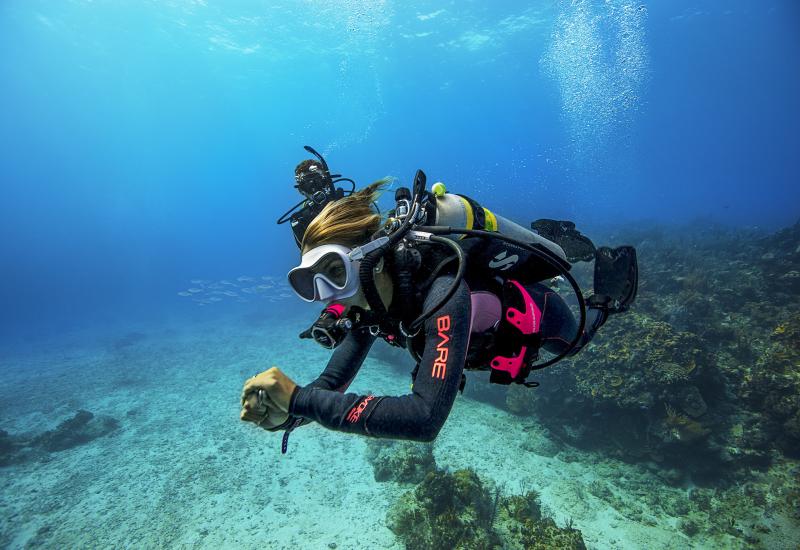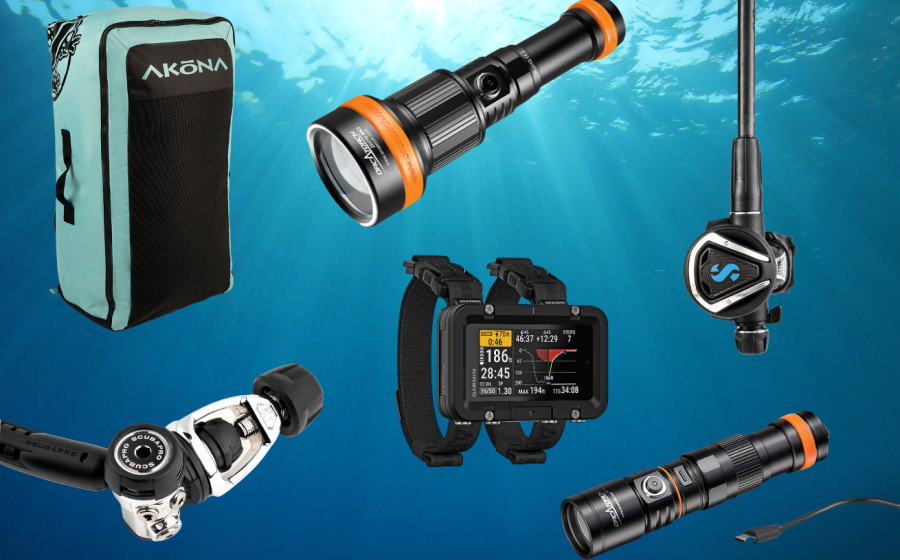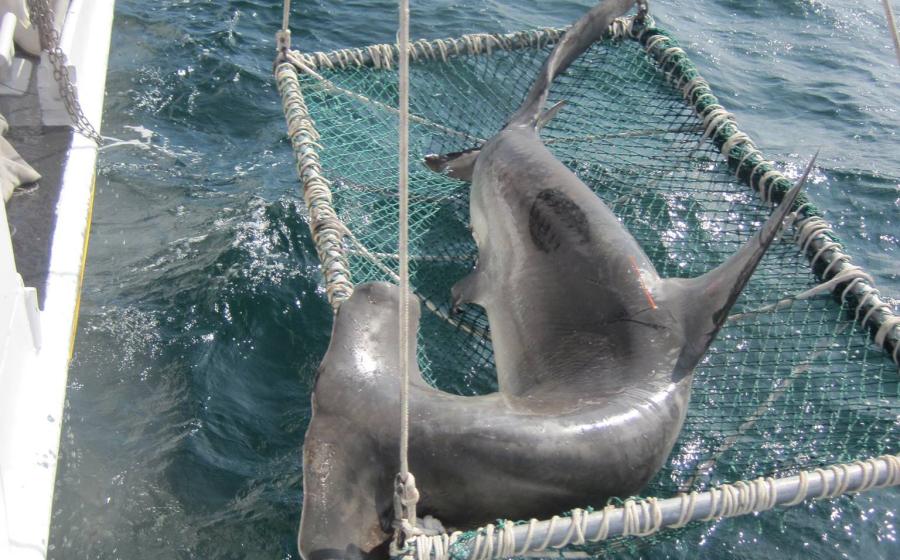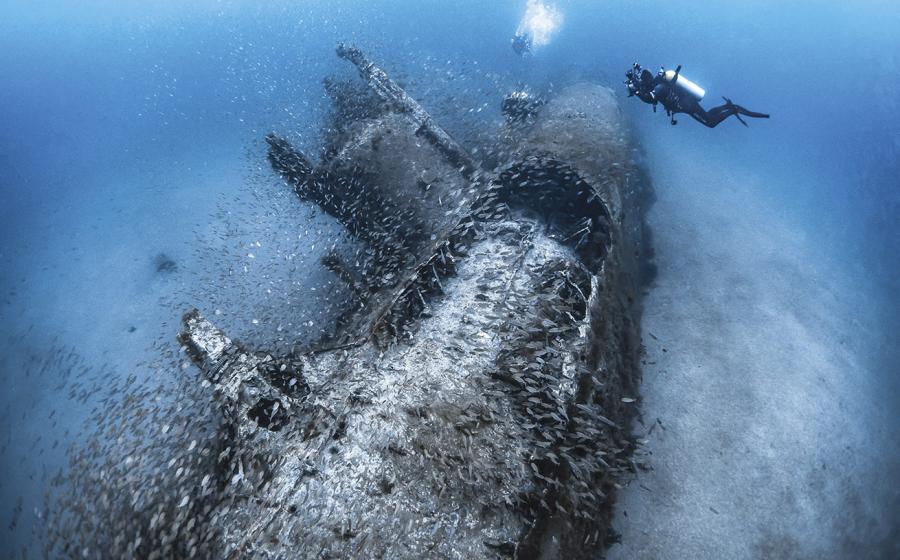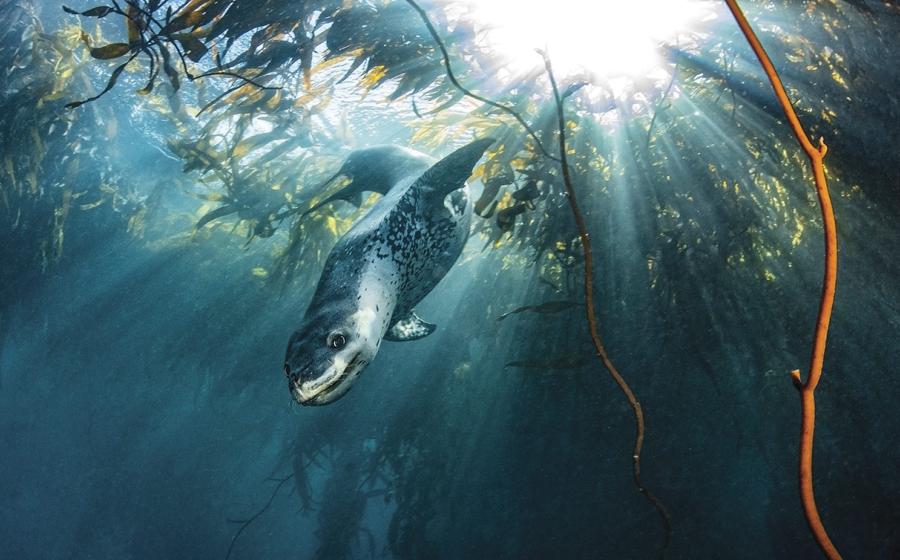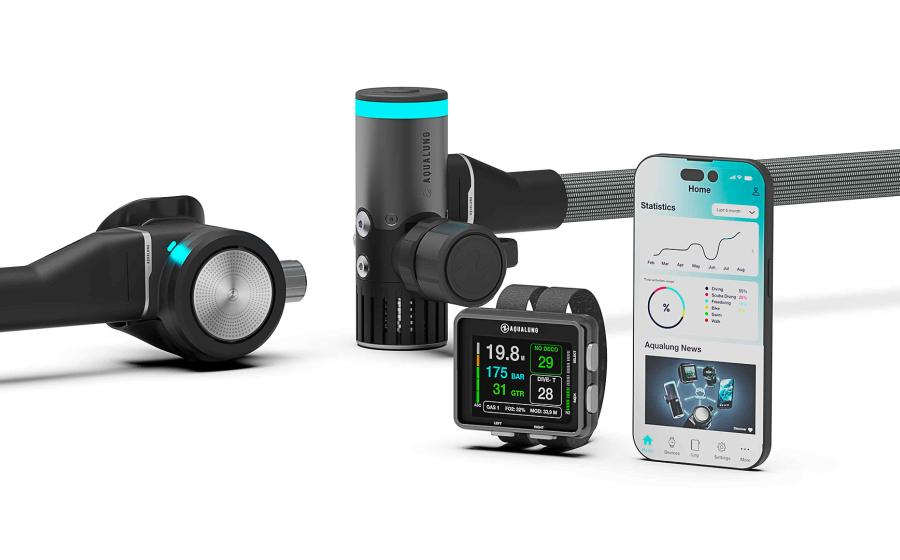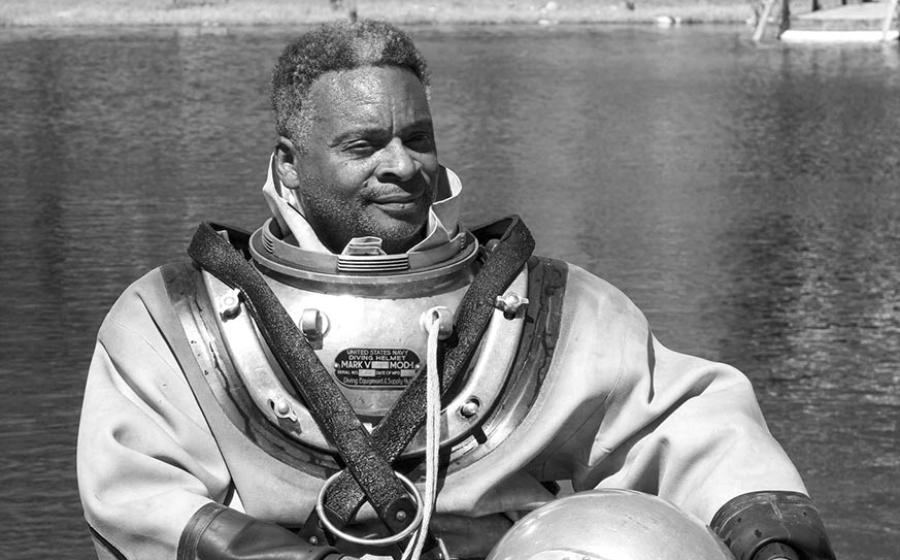Sidemount Cave Diving in the Dominican Republic
As dawn breaks over Bayahibe — a once sleepy fishing village turned bustling dive hot spot in southeast Dominican Republic — the usual suspects begin to stir along the dirt road outside my apartment. Roosters warm up their vocal cords across the street. Dogs flop down in patches of early light. From my balcony, I spot a rising dust cloud from my ride as Uwe Rath rolls up, truck bed loaded with cave-diving gear.
Our plan is a full-penetration dive into the first leg of Chicho Cave, a crystal-clear freshwater cenote that lies beneath the arid scrub brush of the DR’s Parque Nacional del Este (National Park of the East). Most divers know about the cenotes of Mexico’s Yucatan Peninsula, but few realize that similar systems can be found elsewhere in the Caribbean. That goes double for the Dominican Republic, where above-ground cave systems boast a wealth of native, pre-colonial Taino cave paintings and artifacts, and the underwater rivers that connect them remain largely untouched and unexplored.
Rath is one of only two cave instructor-trainers in the country, and a local cave-diving pioneer who has been an integral member of initial expeditions to explore and name the caves that comprise the Dominican Republic’s underwater-river network. A past expedition turned up a skull and bones from a previously unknown species of ancient mammal, which is now being studied by the Museum of the Dominican Man in Santo Domingo.
Rath is also a gregarious German who has spent more than two decades in the DR, owning and operating dive shops in every corner of the country. His latest operation, Uwe Scuba, is a custom dive center that has its storefront in the exclusive Casa de Campo resort, about 14 miles from Bayahibe. But don’t worry if, like me and most divers, you can’t afford Casa de Campo’s presidential digs — Bill Clinton, Jimmy Carter and George H.W. Bush all have vacationed here — Rath also makes house calls to meet divers who are down for a personalized, off-the-beaten-track experience.
Bottom line: If you’re an advanced or technical diver looking for an out-of-the-ordinary underwater adventure in the Dominican Republic, Rath is the fixer who can make it happen.
Sidemount on St. George
Before we go underground, we plan to make our first dives together in open ocean, so Rath commandeers a local dive boat, and we head out of Bayahibe’s bustling loading dock to the DR’s signature wreck dive, the St. George.
We’re diving sidemount, a technical BCD system that has clips to carry tanks under our arms rather than on our backs. The benefts are many, the main one being redundancy — every diver has two tanks, each with its own regulator. It also helps us keep a fat swimming position in the water, ideal for penetrating wrecks and caves where we need to avoid kicking up sediment on the bottom. Carrying the tanks protected under our arms helps reduce snags, and makes us more flexible in tight interior spaces.
Less than 10 minutes from the loading ramp at the heart of Bayahibe — now buzzing with activity as boats vie to board gaggles of European divers, snorkelers and sun seekers — our boat idles into position, mooring over the wreck.
We clip our tanks under our arms as we make our final checks and slip into the water. As I sink beneath the swim step, angling for the down line, I see the tower of the St. George rising proudly from the sandy seafloor about 140 feet below, amid swarms of jack fish that seem like they’re raining upward in slow motion.
The nearly 250-foot steel freighter was sunk as an artificial reef in 1999; today it remains intact and upright, with a profusion of fish and corals. Nearing the sandy bottom, we fare out with our arms forward and glide into the ship’s superstructure with methodical frog kicks, exploring deep beneath the deck of the cargo holds, along the exterior walkways, and through the wheelhouse.
We finalize our afternoon plans over pizza on the Bayahibe waterfront before loading into Rath’s truck and heading inland. Much of the area surrounding Bayahibe — on land and in the water — is the protected National Park of the East. This includes offshore dive favorites at Saona and Catalina islands, as well as the inland Padre Nuestro area, a hot, arid jungle of scrub brush atop karst limestone, which is where we’re headed.
Into Chicho Cave
We pull of the main road at a gate that opens onto a steeply inclined, rutted dirt track. As we bounce our way up the road, men materialize from the forest and approach the truck. Rath gestures for them to hop in back — once we arrive at the dive site, I understand why.
We park in a clearing at a trailhead that winds steeply down rough steps hewn from logs and rocks. The men who joined us jump into action, making quick work of carrying our tanks, weights and gear bags down the rugged path. The final steps of the trail lead down slick rock into the gaping maw of the cave. From the surface, the electric blue of the water illuminated by the overhead sun beckons like a siren, singing songs of exploration and adventure.
After hiking under the hot Caribbean sun in a 5 mm wetsuit, I relish the cool rush against my skin as I dunk into the cenote and don my gear. As we descend into the freshwater basin beneath us, we turn our dive lights toward the darkness.
The beam of my light picks up the telltale glint of a bright-white cave line, and I see the ghostly string disappear through a hole in the wall: our entrance to Chicho Cave. We make a final check, then frog-kick inside, hovering just above the guide line that leads the way to the end of the passage.
Inside the tunnel, the water is deceptively clear, playing tricks with my mind. My bubbles are the only sign that I haven’t already come up for air. We wind an undulating path around incredible rock formations. Fat stalagmites sit like half-melted candles, while sections of the ceiling bristle like pincushions, blanketed by spiny stalactites. After 25 minutes, the tunnel angles upward and soon opens into a wide room. I watch Rath above me and see his head disappear as he surfaces into an air chamber above us.
I follow him to the surface, where he explains it’s safe to remove my regulator — though dark, the room is connected to the outside world, and thus there’s fresh air for us to breathe. I flash my light on the ceiling above, watching the beam bounce over rock in the humid air. I can’t help but feel privileged to be here. Rath and others may have only just started exploring the Dominican Republic’s cave systems, but if those caves that remain to be found look anything like this one, they won’t remain secret for long.
What It Takes
Cave diving requires special training, equipment and experience. Uwe Scuba uses sidemount gear for cave diving; a sidemount-certification class can provide you with all the necessary skills and equipment. Any open-water diver who is at least 15 years old can take a PADI Sidemount Diver course; you can apply the dives to an Advanced certification. You should also have a Cave Diver cert, or you can join an Intro to Cave course to learn to properly use guidelines, line markers, dive lights and redundant-air supplies. Prerequisites for Intro to Cave are a Cavern Diver certification and a minimum of 25 logged dives.
Need to Know
Operator: UweScuba (uwescuba.com) is one of a select few operators that can arrange proper technical dives into DR’s cave systems, as well as teach PADI Tec Rec programs for Sidemount, Intro to Cave and Cave Diver courses.
When to go: Bayahibe and nearby Punta Cana are year-round dive destinations, with warm, protected water. As with most Caribbean destinations, winter is the high season; late summer is the low season.
Dive conditions: Ocean conditions stay calm year-round in Bayahibe, with water temps ranging from high 70s to mid-80s and visibility from 60 to 120 feet. In the freshwater caves, the water always stays in the mid-70s, with a visibility of 150 feet.
Price tag: A single guided cave dive costs $110; two dives in different caves run $170. If you don’t have cave-diving experience, Uwe Scuba offers classes. PADI’s TecRec Sidemount course costs $420; a TDI Intro to Cave certification costs $590.
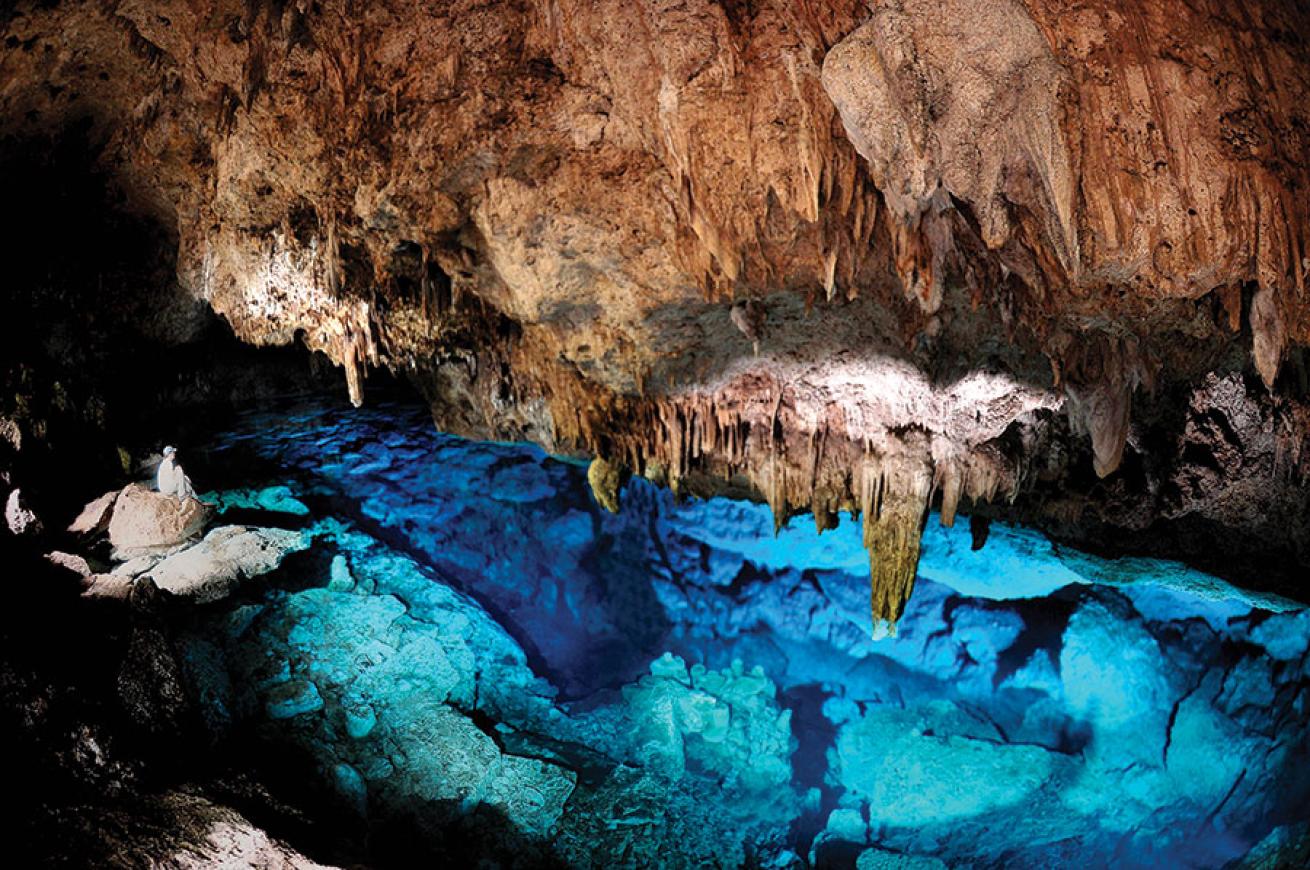
Curt BowenThe Dominican Republic's ancient underground river system is a new frontier in diving.
As dawn breaks over Bayahibe — a once sleepy fishing village turned bustling dive hot spot in southeast Dominican Republic — the usual suspects begin to stir along the dirt road outside my apartment. Roosters warm up their vocal cords across the street. Dogs flop down in patches of early light. From my balcony, I spot a rising dust cloud from my ride as Uwe Rath rolls up, truck bed loaded with cave-diving gear.
Our plan is a full-penetration dive into the first leg of Chicho Cave, a crystal-clear freshwater cenote that lies beneath the arid scrub brush of the DR’s Parque Nacional del Este (National Park of the East). Most divers know about the cenotes of Mexico’s Yucatan Peninsula, but few realize that similar systems can be found elsewhere in the Caribbean. That goes double for the Dominican Republic, where above-ground cave systems boast a wealth of native, pre-colonial Taino cave paintings and artifacts, and the underwater rivers that connect them remain largely untouched and unexplored.
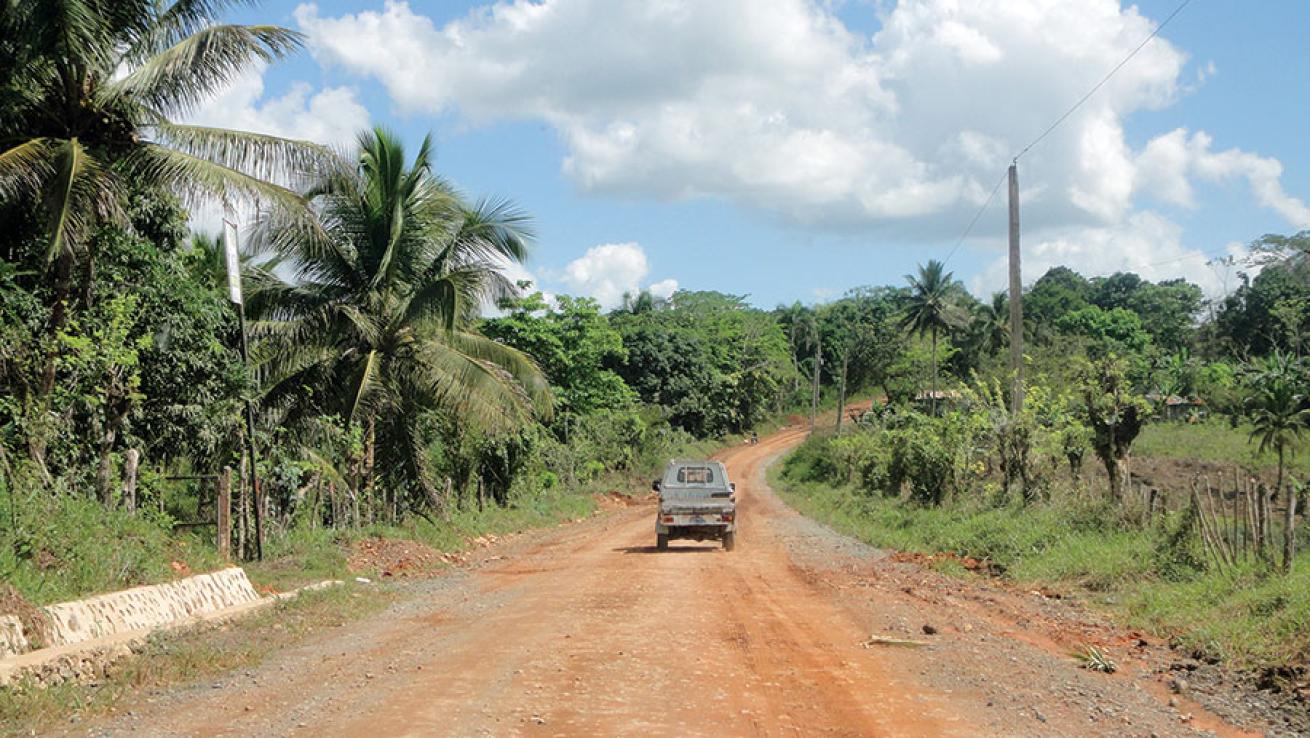
Becky Kagan SchottDivers load up a truck and hit the road on their way to Chicho Cave, Dominican Republic.
Rath is one of only two cave instructor-trainers in the country, and a local cave-diving pioneer who has been an integral member of initial expeditions to explore and name the caves that comprise the Dominican Republic’s underwater-river network. A past expedition turned up a skull and bones from a previously unknown species of ancient mammal, which is now being studied by the Museum of the Dominican Man in Santo Domingo.

Jose Alejandro AlvarezInside Chicho cave, the clear water reveals fantastical formations.
Rath is also a gregarious German who has spent more than two decades in the DR, owning and operating dive shops in every corner of the country. His latest operation, Uwe Scuba, is a custom dive center that has its storefront in the exclusive Casa de Campo resort, about 14 miles from Bayahibe. But don’t worry if, like me and most divers, you can’t afford Casa de Campo’s presidential digs — Bill Clinton, Jimmy Carter and George H.W. Bush all have vacationed here — Rath also makes house calls to meet divers who are down for a personalized, off-the-beaten-track experience.
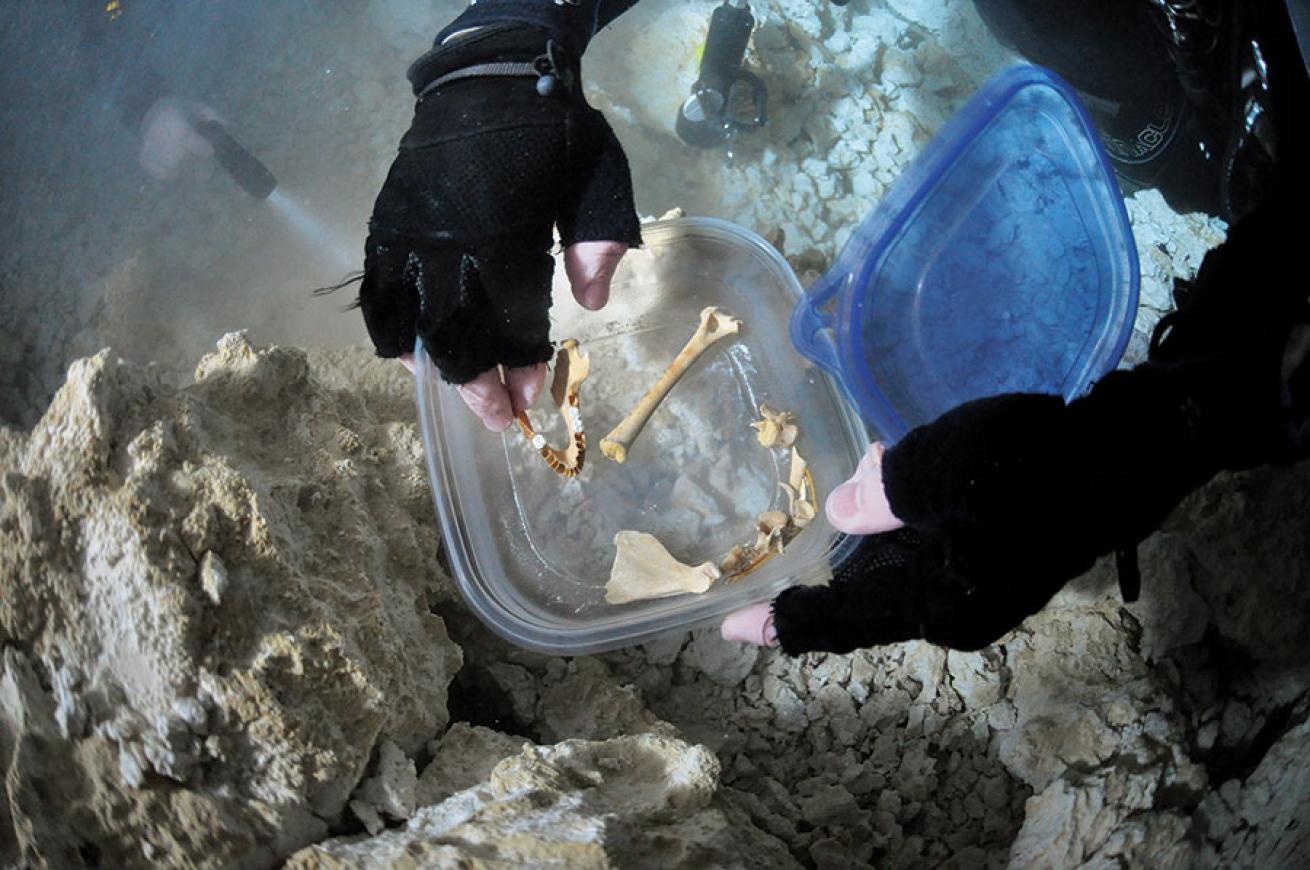
Curt BowenThe bones of an extinct primate were discovered near Chicho Cave in the Dominican Republic.
Bottom line: If you’re an advanced or technical diver looking for an out-of-the-ordinary underwater adventure in the Dominican Republic, Rath is the fixer who can make it happen.
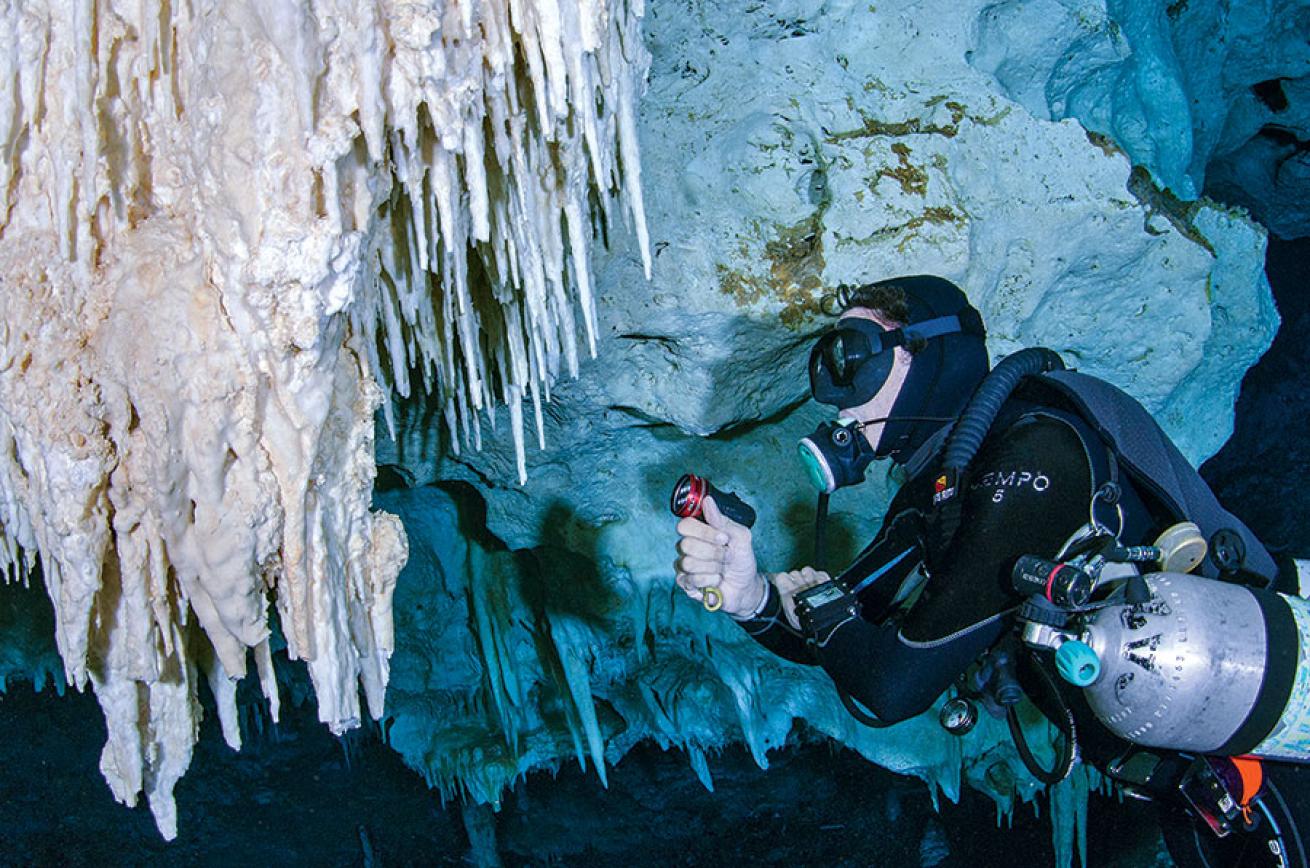
Jose Alejandro AlvarezAccessing Chicho Cave in the Dominican Republic is difficult but worth it.
Sidemount on St. George
Before we go underground, we plan to make our first dives together in open ocean, so Rath commandeers a local dive boat, and we head out of Bayahibe’s bustling loading dock to the DR’s signature wreck dive, the St. George.
We’re diving sidemount, a technical BCD system that has clips to carry tanks under our arms rather than on our backs. The benefts are many, the main one being redundancy — every diver has two tanks, each with its own regulator. It also helps us keep a fat swimming position in the water, ideal for penetrating wrecks and caves where we need to avoid kicking up sediment on the bottom. Carrying the tanks protected under our arms helps reduce snags, and makes us more flexible in tight interior spaces.
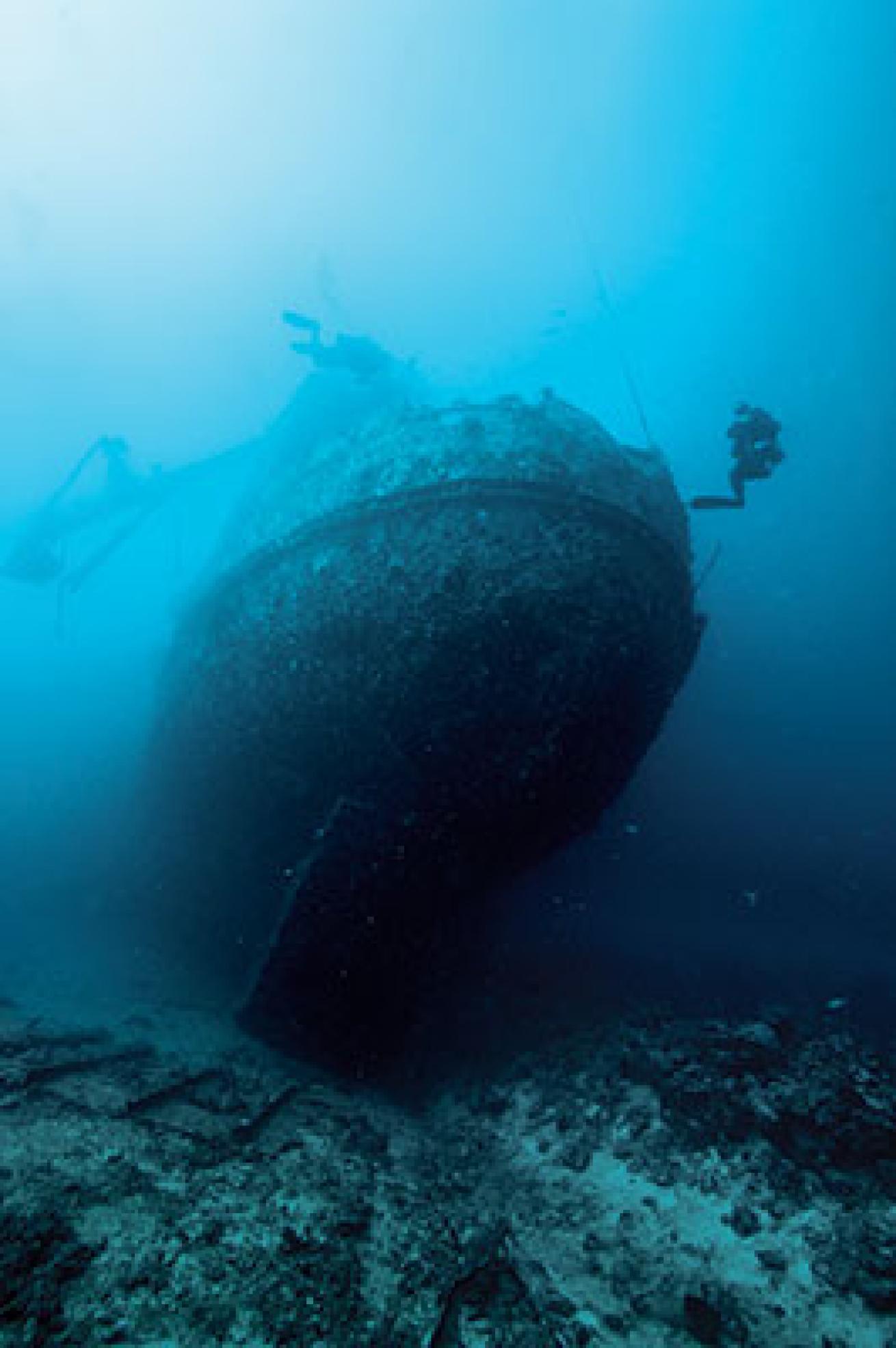
Becky Kagan SchottThe St. George wreck looms in the deep.
Less than 10 minutes from the loading ramp at the heart of Bayahibe — now buzzing with activity as boats vie to board gaggles of European divers, snorkelers and sun seekers — our boat idles into position, mooring over the wreck.
We clip our tanks under our arms as we make our final checks and slip into the water. As I sink beneath the swim step, angling for the down line, I see the tower of the St. George rising proudly from the sandy seafloor about 140 feet below, amid swarms of jack fish that seem like they’re raining upward in slow motion.
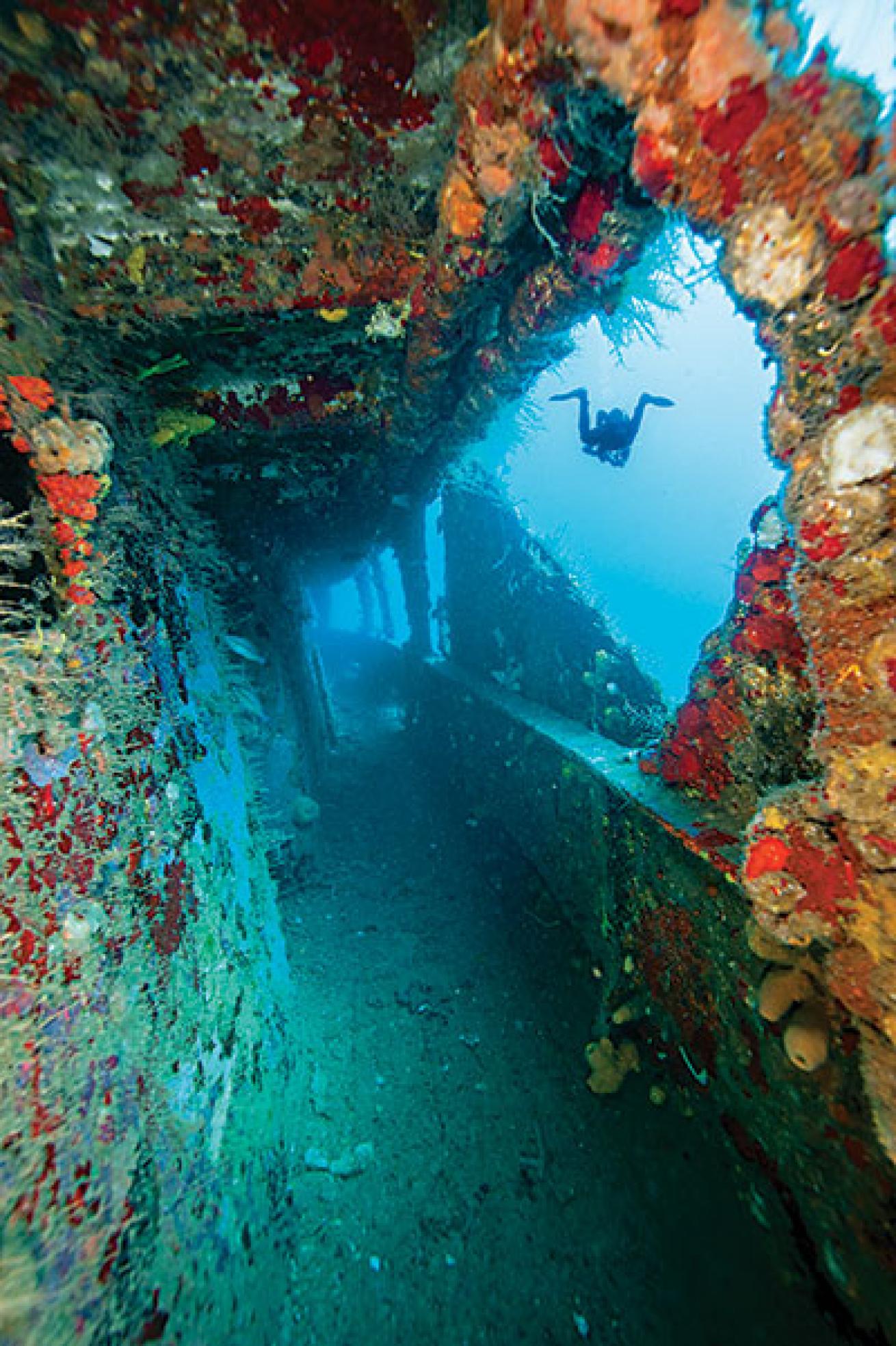
Becky Kagan SchottThe St. George is a sponge-encrusted wreck that offers exploration-worthy walkways.
The nearly 250-foot steel freighter was sunk as an artificial reef in 1999; today it remains intact and upright, with a profusion of fish and corals. Nearing the sandy bottom, we fare out with our arms forward and glide into the ship’s superstructure with methodical frog kicks, exploring deep beneath the deck of the cargo holds, along the exterior walkways, and through the wheelhouse.
We finalize our afternoon plans over pizza on the Bayahibe waterfront before loading into Rath’s truck and heading inland. Much of the area surrounding Bayahibe — on land and in the water — is the protected National Park of the East. This includes offshore dive favorites at Saona and Catalina islands, as well as the inland Padre Nuestro area, a hot, arid jungle of scrub brush atop karst limestone, which is where we’re headed.
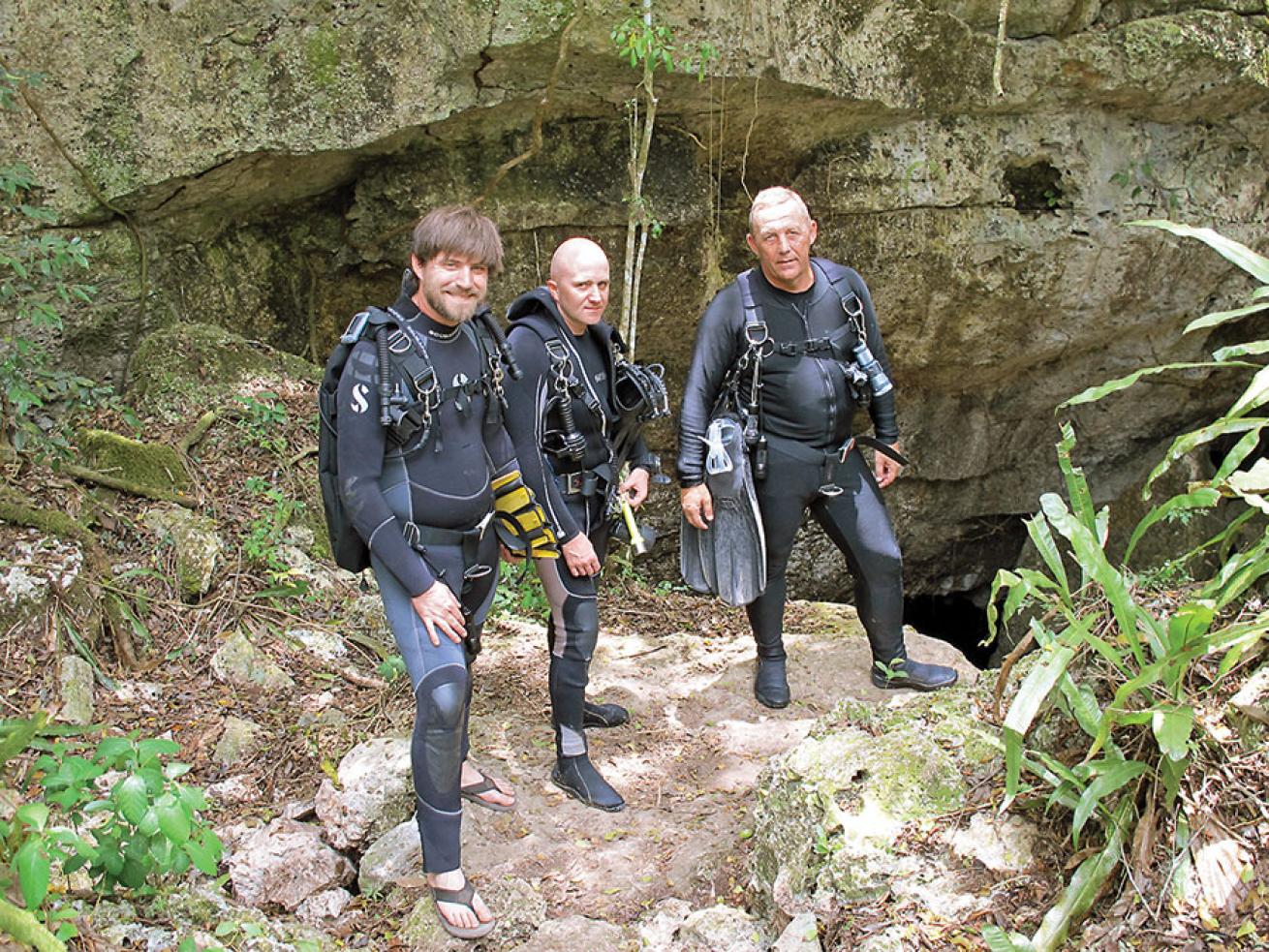
Courtesy Uwe RathTravis Marshall, Juergen Riedl and Uwe Rath outside of Chicho Cave.
Into Chicho Cave
We pull of the main road at a gate that opens onto a steeply inclined, rutted dirt track. As we bounce our way up the road, men materialize from the forest and approach the truck. Rath gestures for them to hop in back — once we arrive at the dive site, I understand why.
We park in a clearing at a trailhead that winds steeply down rough steps hewn from logs and rocks. The men who joined us jump into action, making quick work of carrying our tanks, weights and gear bags down the rugged path. The final steps of the trail lead down slick rock into the gaping maw of the cave. From the surface, the electric blue of the water illuminated by the overhead sun beckons like a siren, singing songs of exploration and adventure.
After hiking under the hot Caribbean sun in a 5 mm wetsuit, I relish the cool rush against my skin as I dunk into the cenote and don my gear. As we descend into the freshwater basin beneath us, we turn our dive lights toward the darkness.
The beam of my light picks up the telltale glint of a bright-white cave line, and I see the ghostly string disappear through a hole in the wall: our entrance to Chicho Cave. We make a final check, then frog-kick inside, hovering just above the guide line that leads the way to the end of the passage.
Inside the tunnel, the water is deceptively clear, playing tricks with my mind. My bubbles are the only sign that I haven’t already come up for air. We wind an undulating path around incredible rock formations. Fat stalagmites sit like half-melted candles, while sections of the ceiling bristle like pincushions, blanketed by spiny stalactites. After 25 minutes, the tunnel angles upward and soon opens into a wide room. I watch Rath above me and see his head disappear as he surfaces into an air chamber above us.
I follow him to the surface, where he explains it’s safe to remove my regulator — though dark, the room is connected to the outside world, and thus there’s fresh air for us to breathe. I flash my light on the ceiling above, watching the beam bounce over rock in the humid air. I can’t help but feel privileged to be here. Rath and others may have only just started exploring the Dominican Republic’s cave systems, but if those caves that remain to be found look anything like this one, they won’t remain secret for long.
What It Takes
Cave diving requires special training, equipment and experience. Uwe Scuba uses sidemount gear for cave diving; a sidemount-certification class can provide you with all the necessary skills and equipment. Any open-water diver who is at least 15 years old can take a PADI Sidemount Diver course; you can apply the dives to an Advanced certification. You should also have a Cave Diver cert, or you can join an Intro to Cave course to learn to properly use guidelines, line markers, dive lights and redundant-air supplies. Prerequisites for Intro to Cave are a Cavern Diver certification and a minimum of 25 logged dives.
Need to Know
Operator: UweScuba (uwescuba.com) is one of a select few operators that can arrange proper technical dives into DR’s cave systems, as well as teach PADI Tec Rec programs for Sidemount, Intro to Cave and Cave Diver courses.
When to go: Bayahibe and nearby Punta Cana are year-round dive destinations, with warm, protected water. As with most Caribbean destinations, winter is the high season; late summer is the low season.
Dive conditions: Ocean conditions stay calm year-round in Bayahibe, with water temps ranging from high 70s to mid-80s and visibility from 60 to 120 feet. In the freshwater caves, the water always stays in the mid-70s, with a visibility of 150 feet.
Price tag: A single guided cave dive costs $110; two dives in different caves run $170. If you don’t have cave-diving experience, Uwe Scuba offers classes. PADI’s TecRec Sidemount course costs $420; a TDI Intro to Cave certification costs $590.

